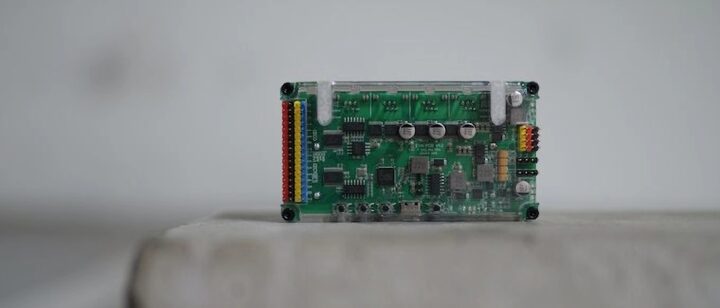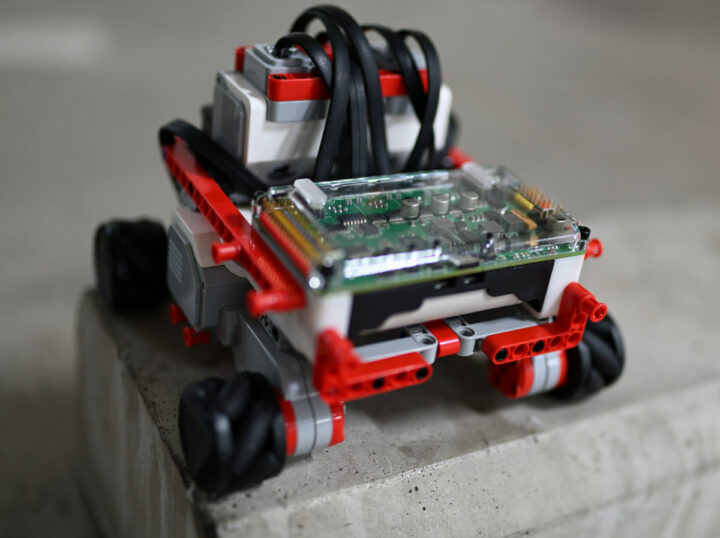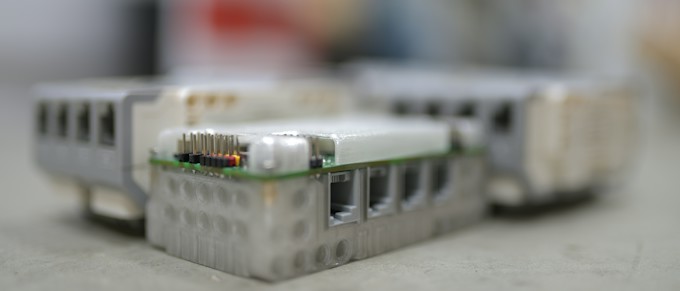The EVN Alpha is a robotics project from a team based in Singapore and is aimed at roboticists seeking an advanced building platform beyond what LEGO Robotics kits offer.

This robotics controller can be considered a spiritual successor to the LEGO MINDSTORMS EV3 intelligent brick. It runs on the Raspberry Pi RP2040 microcontroller with two Cortex M0+ cores running at a maximum clock speed of 133 MHz and 264KB of embedded SRAM and builds upon the rich software support available for the microcontroller.
It features 64 LEGO Technic-compatible holes on five sides for easy installation into your projects and has 26 ports for I2C, UART, servos, EV3, and NXT motors. It is smaller volumetrically than the LEGO bricks and can be powered from two generic 18650 Lithium-ion cells rather than a proprietary solution (unlike the LEGO SPIKE Prime).
The EVN Alpha was created as a “basecamp for students looking to get serious about robotics”. It is a modular platform and the parts and sub-systems can be slowly replaced with self-created solutions until the student reaches a point when they can do away with the controller itself.

EVN Alpha specifications:
- MCU – Raspberry Pi RP2040 dual-core Cortex M0+ microcontroller @ 133 MHz with 264 kB of embedded SRAM
- Channels
- DC Motor + encoder – 4x motor ports compatible with LEGO MINDSTORMS EV3 and NXT motors, 4A peak (3A continuous)
- Servo – 4x motor ports, 5V regulated
- IO – 16x I2C, 2x UART
- USB – 1x USB-C for battery charging, code upload, and debug over serial
- Power – 2-cell Lithium-ion battery, built-in charger
- Misc – Power button, Reset and Boot Select buttons, 1x programmable button, 1x LED
- LEGO support – EV3/NXT motor ports
- Dimensions: 104 x 56 x 40mm
EVN Alpha will be supported by a library that aims to match the official EV3 MicroPython library’s usability and performance. The product will be shipped with guides and resources to enable users to help users get started and process quickly.
The Alpha can be connected to a range of “Standard Peripherals” to expand its IO functionality. These peripherals include sensor, communication, display, and actuation modules compatible with the EVN ALPHA. Each one comes bundled with the IO device, a LEGO Technic-compatible mount, connecting wires, other relevant tools, and a tutorial.
You can find more information about the EVN Alpha robotics controller on the Kickstarter page. You can back this project for as little as $2 and giving $6 will get your name featured in the EVN libraries and website. Other available rewards include:
- Standard Peripheral ($14)
- Hacker Kit – EVN PCB ($36)
- DIY Kit – Build and customize your own EVN Alpha ($58)
- Assembled EVN Alpha Kit ($81)
- Fully loaded kit without batteries – EVN Alpha with 22 Standard Peripherals ($215)
Most of the rewards have an estimated delivery date of August 2024. Crowdfunding for the project began on December 22, 2023, and will end on Feb 20, 2024. The project will only be funded if it reaches its goal of $6,617 by then. This isn’t the first collab between the RP2040 and LEGO we have covered. Check out the LEGO brick with RP2040 that runs DOOM and Raspberry Pi’s Build HAT expansion board.

Tomisin is a writer specializing in hardware product reviews, comparisons, and explainers. He is very passionate about small form factor and single-board computers.
Support CNX Software! Donate via cryptocurrencies, become a Patron on Patreon, or purchase goods on Amazon or Aliexpress







What a sleight of hand – I don’t think RP2040 is even capable of 16 separate I2C ports on its own, PIO or not.
Hey Marcin Dąbrowski, Kenneth here from the EVN team. The 16 I2C ports are multiplexed from the 2 I2C buses on the RP2040. Happy to answer any other questions 🙂
Hello Kenneth, was RP2040 your first choice, or was there a feature that made this the best choice among other candidates?
Hey Marcin, the RP2040 was indeed our first choice. We started conceptualising the EVN (then not called the EVN but that’s another story for another time) against the backdrop of the global supply chain crisis and along with it, chip shortages that led to the premature retirement of popular products. That Raspberry Pi was able to keep stock levels healthy and not take advantage of the situation to inflate prices gave us the confidence that we would be able to work with the RP2040 without the constant worry of a radical redesign being forced upon us. The RP2040 is certainly neither the cheapest, nor the most powerful MCUs in the market. For that, the RISC V Tsunami raging on is much closer to Cost-Performance Pareto optimality. Nonetheless, the RP2040 is more than enough. The Pybricks team has shown that the SPIKE PRIME Hub, clocked lower and running a single core, is able to outperform the EV3 in real-world dead-reckoning with loop closure over odometry and IMU inputs. My own students have also developed robots for RoboCup Junior Soccer (fast, holonomic robots cooperating in a dynamic, adversarial task) and RoboCup Junior Rescue Line with the RP2040 in 2023, giving me confidence that the platform will meet, and likely exceed the needs of most robotics projects. Based on our testing thus far, we’ve not found the RP2040 to be limiting, and are really excited to dig deep into all that it can offer (PIO, C/C++, parallelism etc.) once we’re less bogged down with the initial fulfillment phase. Hope this answers 🙂
Why not also be compatible with Lego robot inventor / Spike prime?
Hey Brad, Kenneth here from the EVN team. Thank you for your question, this is something we have gotten quite a few times.
One of the reasons we build the EVN was to save millions of dollars (maybe more?) of LEGO MINDSTORMS inventory from going into the dumpster. With the EVN ALPHA, we are enabling the re-use of all actuators and LEGO Technic components from MINDSTORMS sets even when the EV3 fails, or when the user has outgrown it.
Developing another version which supports Robot Inventor, SPIKE and all other actuators using the LPF2 connector is actually trivial. However, this did not fit the profile of our core audience when we were first developing the ALPHA (still fully supported and targets a younger group which may not be as ready to move on to Arduino and electronics in general).
That said, we are looking at doing an LPF2 version once we have put the ALPHA out into the world 🙂